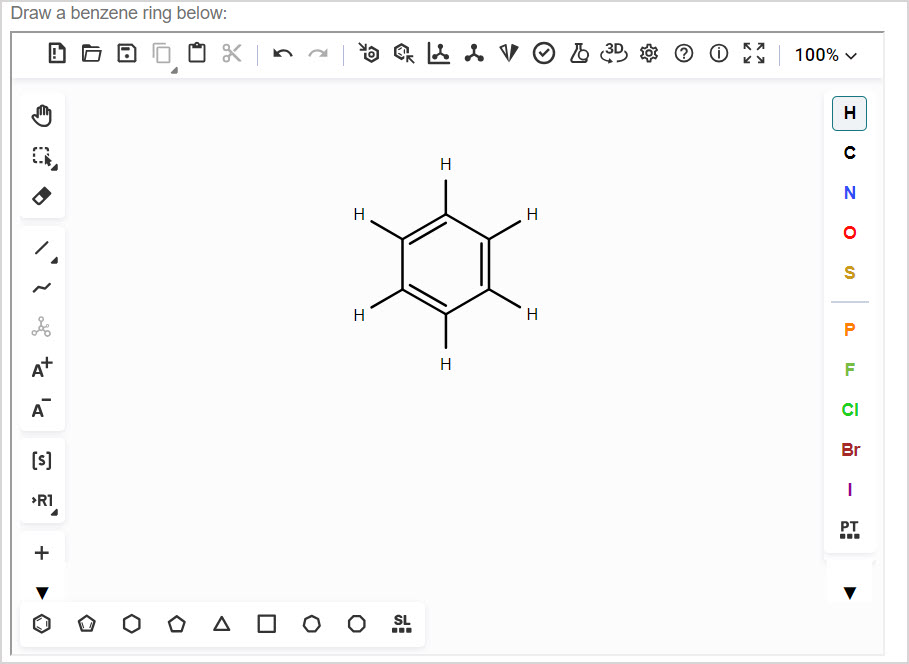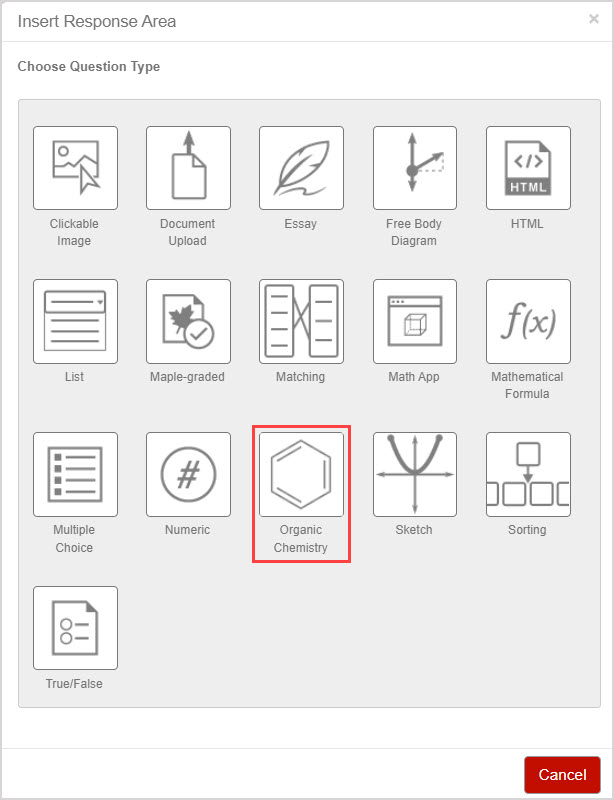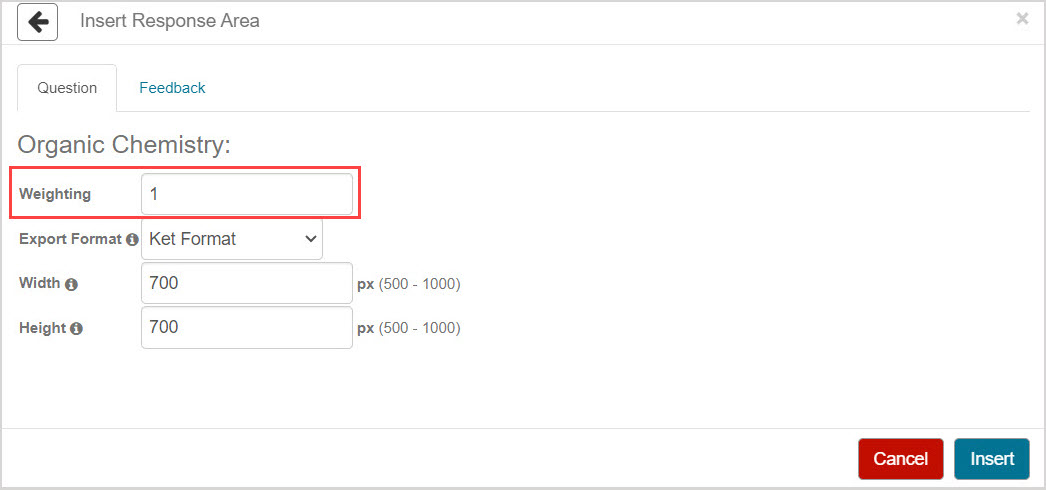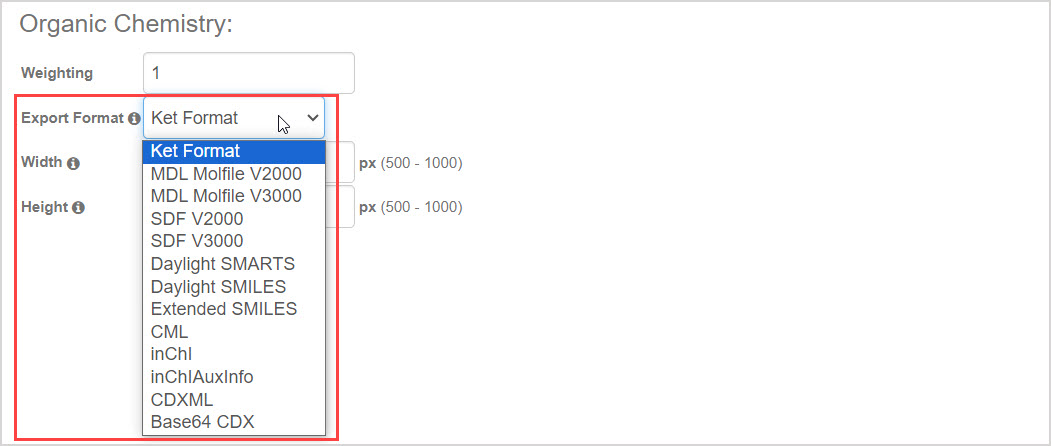Author an organic chemistry question
Jump to section
An organic chemistry question involves students using drawing tools from the Ketcher sketch area to draw chemical structures.

Organic chemistry sketch questions are helpful if you want the student to draw a chemical diagram without having to leave Möbius, or without using a document upload question.
Organic chemistry sketch questions require manual grading.
A read-only static rendering of the student's response is shown for students and instructors, in both the Gradebook and in feedback after the assignment submission.
There are a number of output formats to choose from in the Question Editor, but they control only the format used to store the students drawing in the database.
TIP: You can include an algorithm in your organic chemistry question! Check out Author an algorithmic question.
TIP: All questions are authored using the Question Editor. Check out Author a question to learn how to access the Question Editor.
To author an organic chemistry question
To author an organic chemistry question from the Question Editor:
Enter the question statement in the Question Text pane of the Question Editor.

TIP: Check out Use the Visual Editor for details on how to use this toolbar to the fullest to control the visual appearance of your document upload question text.

Click Response Area
 to select the type of response area for this part of the question.
to select the type of response area for this part of the question.
![]()
NOTE: A question can have multiple question parts. Each question part can have a different type of response area. Example — A question could have the first response area as a document upload response area, and a second response area as multiple choice.
Click Organic Chemistry from the list of response area types.

Assign a weight to the response area. The default response area weighting is 1.

TIP: The response area weight can be any integer greater than 0. Response area weighting is proportionate to the question total. Example — A question with two response areas could have the first response area weighted as 2, and the second response area weighted as 4. This means that the second response area will be worth twice as much as the first response area when calculating the total grade for the question.
Select the preferred format of storing student responses from the Export Format drop-down list.

NOTE: The supported export formats are:
- Ket Format
- MDL Molfile (V2000 and V3000)
- SDF (V2000 and V3000)
- Daylight SMARTS
- Daylight SMILES and Extended SMILES
- CML
- inChl and inChlAuxInfo
- CDXML and Base64 CDX
Enter the desired width and height of the drawing area on the students device.

TIP: The size of the drawing area in the question will be fixed. The minimum width and height is 500 pixels, and the maximum width and height is 1000 pixels.
Click Insert to add this response area to the question.

The response area is inserted into your question.

Click Preview to trial your new question to ensure that it behaves as expected.

TIP: You first have to click the save icon if you're creating this question from within an Activity Editor. After the question has been saved, you can then click the preview icon
if you're creating this question from within an Activity Editor. After the question has been saved, you can then click the preview icon![]() to ensure that your new question behaves as expected.
to ensure that your new question behaves as expected.
NOTE: Previewing your question is the best way to see the drawing tools available to the student. Check out the Ketcher documentation website for more details on each of the drawing tools available in the Ketcher sketch area.

Click Save to save your new question. Your new question is now stored in the Questions pane of the Content Repository.

TIP: Click the save icon if you're creating this question from within an Activity Editor. This saves your question to the activity and the Content Repository.
if you're creating this question from within an Activity Editor. This saves your question to the activity and the Content Repository.
Grading details for organic chemistry questions
Organic chemistry sketch questions appear in the Gradebook but must be manually graded; these question types can't be automatically graded by Möbius.
TIP: Check out Manually grade an organic chemistry question.
Authoring a correct answer or feedback isn't currently supported for organic chemistry questions.
TIP: You can choose to not associate a grade with a student's drawing. Check out step 4 of the To author an organic chemistry question section. Example — You may just want to gain insights into a student's thought process for a question, but not actually grade their scratch work.